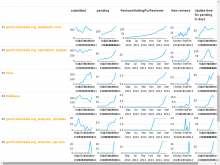In metrics about open Gerrit changesets like http://korma.wmflabs.org/browser/gerrit_review_queue.html , those changesets with -1 should be ignored, because from the point of view of the maintainers they are not in their ToDo list anymore. If those -1 are not touched, they will be eventually abandoned.
This should be applied to all graphs about "pending submissions", "open changesets".
Maybe we should apply a delay in order to avoid graphs changing radically just because a changeset can be pending on Monday, -1 on Tuesday, pending again on Wednesday...
Let's start ignoring those that have been updated more than 30 days ago and have -1. Based on the graphs we get, we may want to fine tune this.
Does "open" include changesets that were submitted, got feedback, and
then
the submitter never bothered to follow up?
Yes, shouldn't we?
Open is open. What would be the best practice with these changesets? Just
leave them open like now, abandon them, mark them with some tag...?Best practise is for author to abandon them if they are not interested any
more. However very few people actually do that. If you want to exclude
them, -1 is a good criteria (-1 patchsets are not waiting on review, so
even if there is still interest, its not in queue).
http://lists.wikimedia.org/pipermail/wikitech-l/2014-April/075646.html
Version: unspecified
Severity: major
